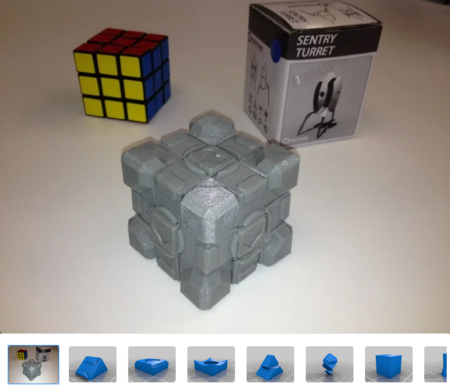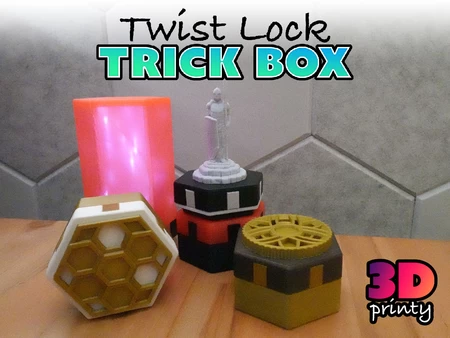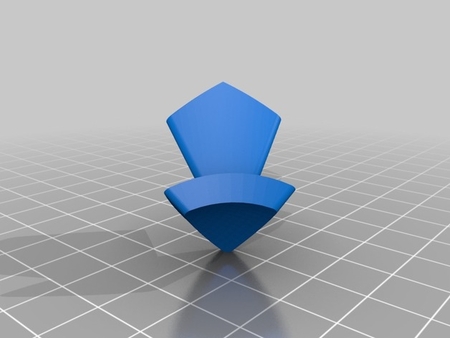Crazy 3x3x3 plus cube (whole original series + 2face series) 3D for print
11918 Views 2 Likes 0 Downloads Download the piece here from 3dforprint
This is a clone of MF8/Dayan Crazy 3x3x3. With this thing you can make a whole series of puzzles including official and non-offi...cial ones. Or you can make a spare piece if you lost or broke one. All parts designed to be exactly same size as original parts, so parts are interchangable between printed and original toy
Each side of the puzzle has a circle. There are 2 types of circle faces: 0 (zero) - inner pieces are fixed, only outer pieces move when face turn, and 1 (one) - both inner and outer pieces move. Different combinations of 0 and 1 faces give 8 official puzzles named after planets. There is also non-official zero cube (all faces are 0). Cube with all 1 faces will work as a regular Rubik's cube.
In fact 0 and 1 faces differ only with center piece, all other pieces remain the same. This allows a trick to have just one cube and switch only center pieces to get another puzzle.
Some people were inspired by Crazy Tetrahedron puzzle where one more face type is introduced - type 2. In fact this is a regular cube face without the circle. The tricky point here is that non-circle pieces bandage cube at some positions and do not allow certain moves of 0 faces.
Different combinations of 0, 1 and 2 faces give over 40 different puzzles to have even more fun. Refer to
http://twistypuzzling.blogspot.com/2014/11/crazy-2face-puzzle-kit-awesome-value.html
for more info.
I printed the puzzle as stickerless, but stickered version is also possible
Notes to consider
Unlike previous section where I described pros of this thing, this section is mostly about downsides of printing the puzzle and tricky points of the process.
First of all I need to mention that this puzzle is very sensitive to printer calibration. Puzzle has different pieces printed in different directions and all these pieces should match each other. Your printer should produce parts of exactly same size as designed as in XY directions, as well as along Z axis.
Another tricky point is that all parts have to have a nice polished surfaces so that they move smooth over other pieces.
Unfortunately my printer does not produce a good results. Sometimes it 'swallows' few first layers, so overall height appears to be less than needed. Also I had to sand pieces quite a lot, so this also reduces pieces dimensions. This mostly applies to corner pieces.
As result I got quite catchy puzzle that does not turn well. At the same time some pieces are too loose that also leads to stuck when doing turns.
Finally after few hours of playing with this puzzle I found that light plastic pieces (mostly yellow and white) get dirty. Not a big deal, but does not look good. Next time I would print stickered version in black plastic
Keep also in mind that printing and sanding of pieces is a pretty time consuming process. (I spent more that 40h on sanding).
Nevertheless, this is a still playable puzzle and I enjoyed solving different configurations.
Please watch the video
https://youtu.be/XZRzv0WhsAc
Printed cube on the left, factory one on the right. Sorry for taking cube out of camera field of view. It may look as printed cube turn well, but believe me it much worse as factory one. Pay attention at how green side turns.
Original cube uses a pretty smart idea - regular cube cross core and a spherical shell. I would definitely follow same... approach if I had a spare core. Unfortunately I did not have one, so I went other way.
I tried
spherical printed cores
in the past. Those cores had to be printed in PLA (for better interlayer adhesion), and also screw thread was not too robust. This time I wanted to use regular M3 lock nuts as well as my favorite and cheap ABS plastic. I can also use regular M3 screws without having to order special ones for cube cores. Though puzzle still requires springs which I still had to order in a cubicks shop as I have not found them on local market.
My printed core consists of one inner cube with nuts and 6 outer spherical sections which are glued to the inner cube. See a photo of printed core next to factory one.
As for moving parts. Most of the parts are split into 2 or more subparts. This is done to avoid using supports while printing. Also parts are rotated so that applied forces should not crack pieces by layers.
Pay attention at file names. Numbers 0, 1 and 2 represent which face type this piece belong to. Some of the pieces are printed in 2 symmetrical parts - they are marked with R and L suffix.
Please be smart in calculating how much pieces you should print. For 0 and 1 faces there will be 4 inner edges (L+R), 4 outer edges, 4 inner corners (L+R), 4 outer corners (L+R), center and cap (top and bottom). For type 2 faces - same thing, but do not include inner corners and edges.
Center cap is glued of 2 pieces - one is facial, other with hooks.
Centers have membranes for easier printing. Remove them with a drill.
While inner/outer edges as well as inner cornes are easy to assemble (just glue L and R parts), outer corners are quire tricky. Each corner will consist of 6 pieces. I doubt 6 printed parts can be glued as is. I glued 3 parts which should come as a one half of the Corner. Then I sanded flat part of resulting composite piece so that it is really flat and can be glued to flat sanded face of another corner triplet.
Recommendations
You would be suprprised, but I do not recommend printing this thing, unless your 3d printer produce supperior quality parts. Printing and sanding will lake you a lot of time, while the resulting quality will be much worse than original toy.
I would recommend buying original puzzles which turn much better. The best way is to buy 2 complimentary puzzles (please google which ones). You'll get a full set of pieces, as well as 6 pcs type 0 centers + 6 pcs type 1 centers. In other words you'll have enough parts to make any puzzle configuration.
If you want not just original planet puzzles please google a video how to make 2face ones. But you have to order black (stickered) puzzles, not color (stickerless) ones
If you already have one, you can still use this thing to print spare parts or replace broken ones. As I said parts have exactly same dimensions are interchangable with original toy (assuming that center pieces come with cap - these are a little bit different in internal structure). Few printed pirces in a factory produced cube do not make turns worse.
Bottom line
Here is the link to Onshape document where I designed this puzzle. Feel free to clone and make adjustments if needed.
https://cad.onshape.com/documents/11160c2435cccdafa1ed0301/v/79eacc2fef025528d6849b82/e/2d234dad39c32b66db7ce84e
I am open for feedback about the puzzle, design and printing process. I really like to see your makes.
Enjoy your puzzle
UPD 23-Oct-2016: People are asking for a non-split version. I added non-slit pieces for classic crazy cube (faces are 0 or 1). Use your favorite printing method. Parts havr Non-Split prefix in the file name
Print Settings
Printer brand:
RepRap
Printer:
Graber i3
Rafts:
No
Supports:
No
Resolution:
0.2mm layer
Infill:
25%
Designer
grafalex3d model description
Puzzle descriptionThis is a clone of MF8/Dayan Crazy 3x3x3. With this thing you can make a whole series of puzzles including official and non-offi...cial ones. Or you can make a spare piece if you lost or broke one. All parts designed to be exactly same size as original parts, so parts are interchangable between printed and original toy
Each side of the puzzle has a circle. There are 2 types of circle faces: 0 (zero) - inner pieces are fixed, only outer pieces move when face turn, and 1 (one) - both inner and outer pieces move. Different combinations of 0 and 1 faces give 8 official puzzles named after planets. There is also non-official zero cube (all faces are 0). Cube with all 1 faces will work as a regular Rubik's cube.
In fact 0 and 1 faces differ only with center piece, all other pieces remain the same. This allows a trick to have just one cube and switch only center pieces to get another puzzle.
Some people were inspired by Crazy Tetrahedron puzzle where one more face type is introduced - type 2. In fact this is a regular cube face without the circle. The tricky point here is that non-circle pieces bandage cube at some positions and do not allow certain moves of 0 faces.
Different combinations of 0, 1 and 2 faces give over 40 different puzzles to have even more fun. Refer to
http://twistypuzzling.blogspot.com/2014/11/crazy-2face-puzzle-kit-awesome-value.html
for more info.
I printed the puzzle as stickerless, but stickered version is also possible
Notes to consider
Unlike previous section where I described pros of this thing, this section is mostly about downsides of printing the puzzle and tricky points of the process.
First of all I need to mention that this puzzle is very sensitive to printer calibration. Puzzle has different pieces printed in different directions and all these pieces should match each other. Your printer should produce parts of exactly same size as designed as in XY directions, as well as along Z axis.
Another tricky point is that all parts have to have a nice polished surfaces so that they move smooth over other pieces.
Unfortunately my printer does not produce a good results. Sometimes it 'swallows' few first layers, so overall height appears to be less than needed. Also I had to sand pieces quite a lot, so this also reduces pieces dimensions. This mostly applies to corner pieces.
As result I got quite catchy puzzle that does not turn well. At the same time some pieces are too loose that also leads to stuck when doing turns.
Finally after few hours of playing with this puzzle I found that light plastic pieces (mostly yellow and white) get dirty. Not a big deal, but does not look good. Next time I would print stickered version in black plastic
Keep also in mind that printing and sanding of pieces is a pretty time consuming process. (I spent more that 40h on sanding).
Nevertheless, this is a still playable puzzle and I enjoyed solving different configurations.
Please watch the video
https://youtu.be/XZRzv0WhsAc
Printed cube on the left, factory one on the right. Sorry for taking cube out of camera field of view. It may look as printed cube turn well, but believe me it much worse as factory one. Pay attention at how green side turns.
3d model print parameters
Printing pieces and assemblyOriginal cube uses a pretty smart idea - regular cube cross core and a spherical shell. I would definitely follow same... approach if I had a spare core. Unfortunately I did not have one, so I went other way.
I tried
spherical printed cores
in the past. Those cores had to be printed in PLA (for better interlayer adhesion), and also screw thread was not too robust. This time I wanted to use regular M3 lock nuts as well as my favorite and cheap ABS plastic. I can also use regular M3 screws without having to order special ones for cube cores. Though puzzle still requires springs which I still had to order in a cubicks shop as I have not found them on local market.
My printed core consists of one inner cube with nuts and 6 outer spherical sections which are glued to the inner cube. See a photo of printed core next to factory one.
As for moving parts. Most of the parts are split into 2 or more subparts. This is done to avoid using supports while printing. Also parts are rotated so that applied forces should not crack pieces by layers.
Pay attention at file names. Numbers 0, 1 and 2 represent which face type this piece belong to. Some of the pieces are printed in 2 symmetrical parts - they are marked with R and L suffix.
Please be smart in calculating how much pieces you should print. For 0 and 1 faces there will be 4 inner edges (L+R), 4 outer edges, 4 inner corners (L+R), 4 outer corners (L+R), center and cap (top and bottom). For type 2 faces - same thing, but do not include inner corners and edges.
Center cap is glued of 2 pieces - one is facial, other with hooks.
Centers have membranes for easier printing. Remove them with a drill.
While inner/outer edges as well as inner cornes are easy to assemble (just glue L and R parts), outer corners are quire tricky. Each corner will consist of 6 pieces. I doubt 6 printed parts can be glued as is. I glued 3 parts which should come as a one half of the Corner. Then I sanded flat part of resulting composite piece so that it is really flat and can be glued to flat sanded face of another corner triplet.
Recommendations
You would be suprprised, but I do not recommend printing this thing, unless your 3d printer produce supperior quality parts. Printing and sanding will lake you a lot of time, while the resulting quality will be much worse than original toy.
I would recommend buying original puzzles which turn much better. The best way is to buy 2 complimentary puzzles (please google which ones). You'll get a full set of pieces, as well as 6 pcs type 0 centers + 6 pcs type 1 centers. In other words you'll have enough parts to make any puzzle configuration.
If you want not just original planet puzzles please google a video how to make 2face ones. But you have to order black (stickered) puzzles, not color (stickerless) ones
If you already have one, you can still use this thing to print spare parts or replace broken ones. As I said parts have exactly same dimensions are interchangable with original toy (assuming that center pieces come with cap - these are a little bit different in internal structure). Few printed pirces in a factory produced cube do not make turns worse.
Bottom line
Here is the link to Onshape document where I designed this puzzle. Feel free to clone and make adjustments if needed.
https://cad.onshape.com/documents/11160c2435cccdafa1ed0301/v/79eacc2fef025528d6849b82/e/2d234dad39c32b66db7ce84e
I am open for feedback about the puzzle, design and printing process. I really like to see your makes.
Enjoy your puzzle
UPD 23-Oct-2016: People are asking for a non-split version. I added non-slit pieces for classic crazy cube (faces are 0 or 1). Use your favorite printing method. Parts havr Non-Split prefix in the file name
Print Settings
Printer brand:
RepRap
Printer:
Graber i3
Rafts:
No
Supports:
No
Resolution:
0.2mm layer
Infill:
25%




























